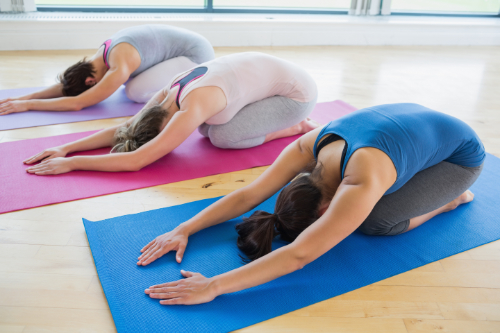Four Stretches Back Pain Suffers Can Do At Home
If you are like most people, at some point in your life you will experience back pain – if you haven’t already. The American Chiropractic Association estimates that around 80% of the population suffers from back pain, has suffered from back pain, or at some point in the future will suffer from back pain. That puts you in pretty good company.
It also means that you have a better than average chance of falling into that 80% so the smart thing to do is take steps not to prevent it. One powerful preventative measure against back pain is stretching. Try these four stretches to help your back pain.
Forward Bend
Stand with your feet shoulder width apart and your knees soft (not locked). Take a deep breath and as you exhale, bend forward at the waist, hands out as if you are reaching for the floor. When you feel a little stretching in your hamstrings (the backs of your legs), stop and hold that position for two or three breaths. If you can’t reach the floor, that is OK, don’t force it. If you need extra stability, you can use a chair to hold on to for balance. Repeat this movement seven to ten times.
Cat and Camel
This stretch is typically done on the floor, but if you don’t think you can safely get back up, you can stand and hold on to a chair. On the floor, get on your hands and knees with your back straight. If using a chair, stand with your feet shoulder width apart and your knees soft. Bend slowly and place your palms in the seat of the chair so that your back is parallel to the floor. Keep it straight.
Begin by arching your back up as high as you can. Hold for two or three breaths. Return to the starting position, then let it sway down toward the floor and hold for two or three breaths. Return to the starting position. Do this five to seven times.
Back Extension
Lie on your stomach on the floor or bed with your hands palm down near your face. Slowly push up with your arms, keeping your head level with your shoulders, until you are on your elbows. Hold for three or four breaths.
If you can push all the way up so that you are on your hands, that will give you a deeper stretch. You can also hold it for a little longer. Just remember to keep the movements slow and gentle to avoid injury.
If you are not able to safely get on the floor, you can stand with your feet several inches from a wall. Place both of your hands on the wall and bring your upper body toward them, letting your pelvis naturally follow. Gently push against the wall with your hands, pushing your upper body away from the wall. You can also do this with a chair if you need extra support. Repeat five to seven times.
Hip Flex and Stretch
Get on your hands and knees on the floor or bed. Slowly move your body back so that your bottom is over your heels. Keep your hips straight as you extend your arms in front of you. Drop your head between your arms and hold the stretch for three to five breaths.
If you can’t get on your hands and knees, sit in a chair with your feet flat on the floor in front of you, hip width apart. Extend your arms in front of you and reach forward. Lean forward slightly until you feel the stretch.
You can also place your hands on your knees for support while you sit in a chair and bend at the waist, slowly rounding out your back over your thighs. Hold the stretch for three to five breaths then return to your upright position. Do this seven to ten times.
Before you begin any new exercise or stretching regimen, talk to your doctor or chiropractor to make sure you aren’t doing something that could exacerbate your problem. For the most part, stretching is very therapeutic and beneficial, but some injuries and conditions can be made worse.
It is well worth taking the extra time to talk with your doctor and perhaps even show him or her the movements. This will also allow them to correct any form problems you may have or recommend any modifications that will help you get the most out of your stretches.


